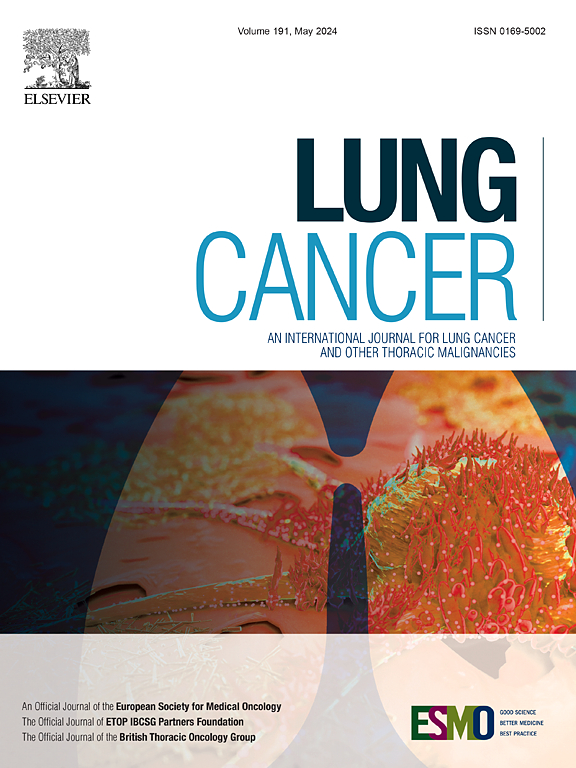揭示第二原发性肺癌的分子和临床风险景观切除非小细胞肺癌
IF 4.4
2区 医学
Q1 ONCOLOGY
引用次数: 0
摘要
肺癌(LC)幸存者发生第二原发性肺癌的风险比一般人群高4 - 6倍。在前瞻性多中心研究中,15 - 17%接受手术切除的LC患者发生第二恶性肿瘤,通常在肺部,风险持续超过5年。我们在一个大型回顾性队列中描述了其发病率和危险因素,包括基因突变。方法本研究回顾性分析了2011年至2023年在东京国立癌症中心医院接受非小细胞肺癌全切除术的5274例患者。第二个主要lc是使用马提尼和梅拉米德标准确定的。我们使用Fine-Gray竞争风险法估计累积发病率,将死亡视为竞争事件,并计算亚分布风险比(SHRs)。结果中位随访时间为4.4年(0 ~ 12年)。总体而言,365例(6.9%)患者在4.1年的中位间隔中发生了第二次原发性LC。手术累积发病率1年为0.7%,5年为6.1%,10年为15.1%。多因素分析发现,重度吸烟史([SHR]: 1.47, 95%可信区间[CI]: 1.07-2.30, p = 0.02)、多发性原发性肺癌(MPLC)的首发状态,定义为基线时同步肿瘤≥2个(SHR: 1.88, 95% CI: 1.25-2.85, p = 0.002)和较高的实变与肿瘤比(SHR: 2.40, 95% CI: 1.67-3.47, p < 0.001)是独立危险因素。在1292例(24.5%)被评估为基因突变的患者中,699例(13.2%)至少携带一种临床可靶向的驱动突变;然而,突变状态不影响第二原发性LC的风险(p = 0.46)。结论重度吸烟史、首发MPLC、较高的CTR增加了继发原发性LC的发生风险;突变状态则没有。具有这些特征的患者需要加强长期监测。本文章由计算机程序翻译,如有差异,请以英文原文为准。

Unveiling the molecular and clinical risk landscape of second primary lung cancer in resected non-small cell lung cancer
Background
Lung cancer (LC) survivors have a 4–6-fold higher risk of developing a second primary LC than the general population. In prospective multicenter studies, 15–17 % of patients undergoing surgical resection for LC develop a second malignancy, often in the lung, with risk persisting beyond 5 years. We characterized its incidence and risk factors, including genetic mutations, in a large retrospective cohort.
Methods
This study retrospectively analyzed 5,274 patients undergoing complete resection for non-small cell lung cancer at the National Cancer Center Hospital Tokyo between 2011 and 2023. Second primary LCs were identified using the Martini and Melamed criteria. We estimated cumulative incidence with the Fine–Gray competing–risk method, treating death as a competing event, and calculated sub–distribution hazard ratios (SHRs).
Results
The median follow-up was 4.4 years (range: 0–12). Overall, 365 (6.9 %) patients developed a second primary LC at a median interval of 4.1 years. Cumulative incidence from surgery was 0.7 % at 1 year, 6.1 % at 5 years, and 15.1 % at 10 years. Multivariate analysis identified heavy smoking history ([SHR]: 1.47, 95 % confidence interval [CI]: 1.07–2.30, p = 0.02), first status of multiple primary lung cancer (MPLC), defined as ≥ 2 synchronous tumors at baseline (SHR: 1.88, 95 % CI: 1.25–2.85, p = 0.002), and higher consolidation-to-tumor ratio (CTR) (SHR: 2.40, 95 % CI: 1.67–3.47, p < 0.001) as independent risk factors. Among 1,292 (24.5 %) patients assessed for genetic mutations, 699 (13.2 %) harbored at least one clinically targetable driver mutation; however, mutation status did not affect risk of second primary LC (p = 0.46).
Conclusions
Heavy smoking history, first status of MPLC, and higher CTR increase the risk of second primary LC; mutation status does not. Patients with these features require intensified, long-term surveillance.
求助全文
通过发布文献求助,成功后即可免费获取论文全文。
去求助
来源期刊

Lung Cancer
医学-呼吸系统
CiteScore
9.40
自引率
3.80%
发文量
407
审稿时长
25 days
期刊介绍:
Lung Cancer is an international publication covering the clinical, translational and basic science of malignancies of the lung and chest region.Original research articles, early reports, review articles, editorials and correspondence covering the prevention, epidemiology and etiology, basic biology, pathology, clinical assessment, surgery, chemotherapy, radiotherapy, combined treatment modalities, other treatment modalities and outcomes of lung cancer are welcome.
 求助内容:
求助内容: 应助结果提醒方式:
应助结果提醒方式:


